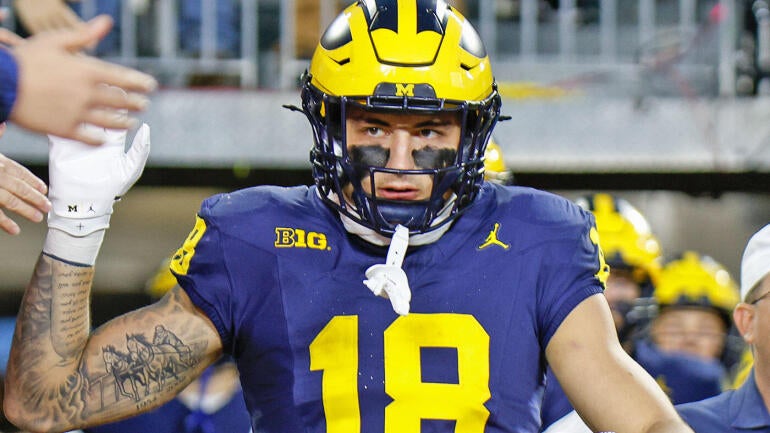

The 2025 NFL Draft has delivered us some talented rookies landing in key situations that impact your Fantasy Football season in 2025 and beyond. Depending on your Dynasty Fantasy Football league settings, you may have only a few days — or hours left to go before your rookie drafts. Some of you may already be on the clock in a slow draft and debating which rookie you want to select from the 2025 NFL Draft class. Some of these decisions are tougher than others and we’re going to start tackling a few of them here. Earlier, I did a deeper dive into some of the draft prospects selected on Day 3 of the NFL Draft who could serve as Dynasty gems later in your rookie drafts — you can find that here. Today, we’ll look at one of the toughest decisions a Fantasy Football manager has to make in the back end of the first round or beginning of the second round of his rookie draft — Bears tight end Colston Loveland or Colts tight end Tyler Warren.
Loveland was selected just before Warren in the first round and joins new play caller Ben Johnson who hails from the most explosive offense in the NFL in Detroit. Sam LaPorta had one of the best rookie seasons for a tight end from a production standpoint and Johnson sees glimpses of LaPorta in Loveland’s game. From my evaluation of their tape, Loveland is the better prospect — more of a threat up the seam, on vertical and out-breaking routes with a larger catch radius, more fluid movement skills after the catch, and more ability to go up and get the football. He also joins a Bears roster with a lot of target competition. They selected Rome Odunze in the first round of last draft, Luther Burden in the second round of this draft and D.J. Moore round out the wide receiver corps. They also still have incumbent starting tight end Cole Kmet.
Warren is built in a different kind of mold. Steichen will likely use him all over the field including lined up in line, as the big slot, in the backfield as an H back, and possibly more. How much the offense will be designed through Warren remains to be determined in training camp. Last offseason, Brock Bowers was built in a similar fashion and showed signs of having the offense designed around him early and throughout camp with the Raiders. If we hear similar things about Warren, it’s not going to matter who is playing quarterback for the Colts — Warren will be touching the football.
Heath Cummings recently updated his Dynasty tight end rankings and discussed the expectations for both Warren and Loveland when it comes to eclipsing the 10-point-per-game mark early in their careers:
Nine tight ends are projected to average 10 Fantasy points per game. A full dozen are projected to score between 8.3 and 9.9 FPPG. It doesn’t look great. But there are ways that could change.
Neither Colston Loveland nor Tyler Warren are projected to top 10 FPPG in Year 1. While we have had some exceptions lately with Sam LaPorta and Brock Bowers, the rule is still that tight ends generally take some time to become must-start options. I will still rank and draft Loveland as a top-12 option because of his talent and upside, but I am more cautious with Warren due to his quarterback situation.
Hunter gets the edge for me over McMillan because of the talent gap I associate with the two receivers. This is not a knock on McMillan. I believe Hunter was the best prospect on tape in this draft class. His diverse release package off the line of scrimmage will make him an immediate red zone mismatch, he can stack in the vertical game, and his loose hips allow him to separate at the top of the route stem on in and out-breaking routes. On top of all of that, he attacks the ball in the air, has excellent flexibility and body control in contested-catch situations, and strong hands at the catch point. If there’s any question mark about his scouting profile it’s the top-end speed.
In our recent one-QB Dynasty startup draft, I took Loveland off the board at No. 65 overall and Heath followed that up just eight picks later with Warren at No. 73 overall.
For me, the debate begins and ends with the quarterback situation. Caleb Williams was one of my highest-graded quarterback prospects since Andrew Luck. I believe he will take a major jump in Year 2 of his NFL career after adding Johnson to devise and call plays, three interior offensive linemen to protect the integrity of the pocket, and two more playmakers in Loveland and Burden. I want the tight end who is tied to Williams vs. the tight end who relies on quarterbacks like Daniel Jones and Anthony Richardson to get him the ball, provide ample scoring and red zone opportunities, and to rack up offensive plays and yardage.
Loveland has a long frame and he knows how to use it to his advantage. In his full scouting profile, Dave Richard compared his game to Darren Waller:
Loveland might prove to be a good blocker, but it’s his receiving skills that will get him drafted early. Given his height, lean limbs, and better-than-normal speed, he is very reminiscent of Darren Waller, who took a while to grow into his role. Loveland should be a quicker study than Waller, but both are former receivers who can exploit mismatches all over the field.
Loveland provides more upside long-term and more stability given his skill set and team situation. That’s my pick for the top tight end in this class.
This news was originally published on this post .



